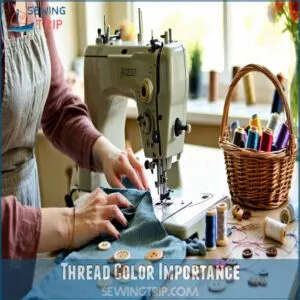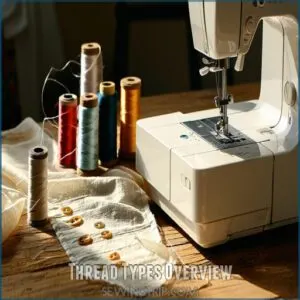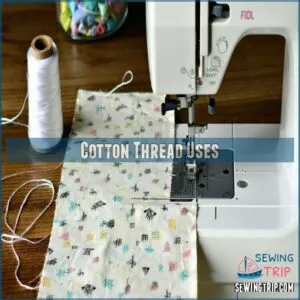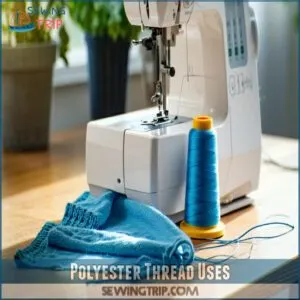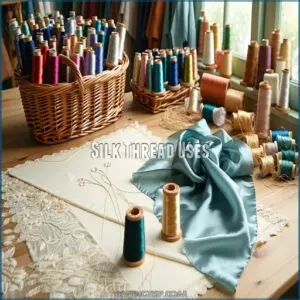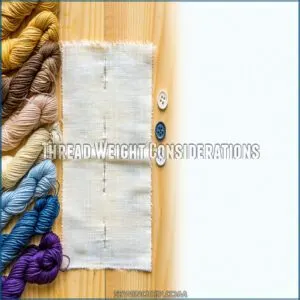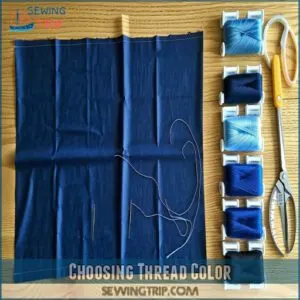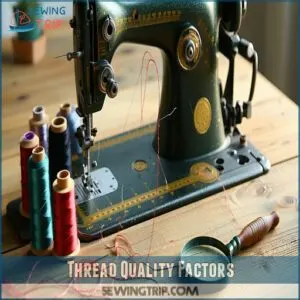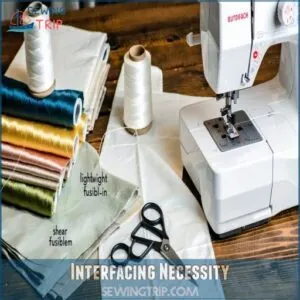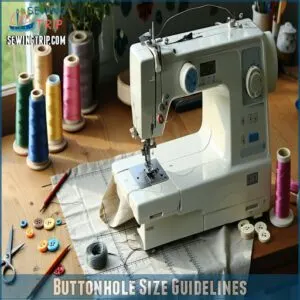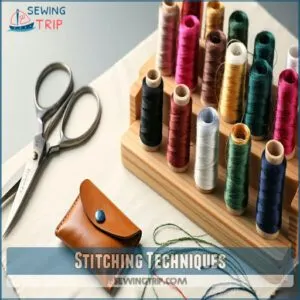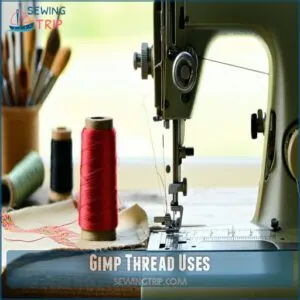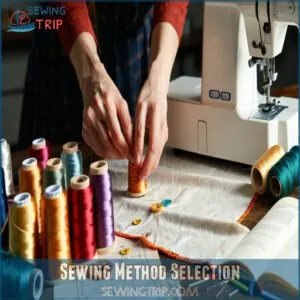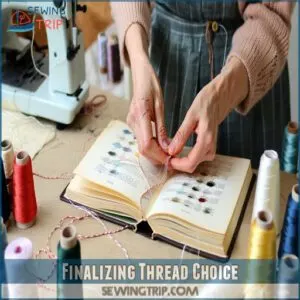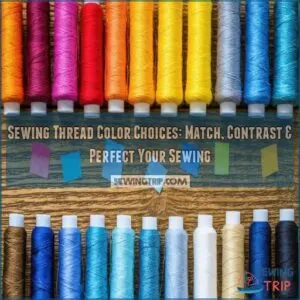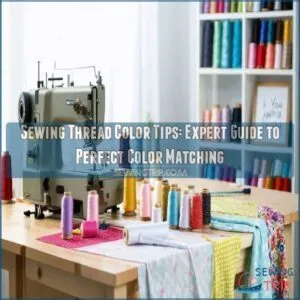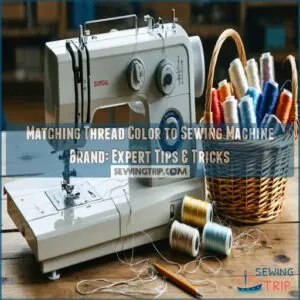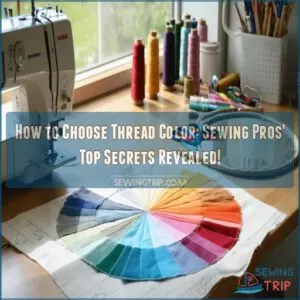This site is supported by our readers. We may earn a commission, at no cost to you, if you purchase through links.
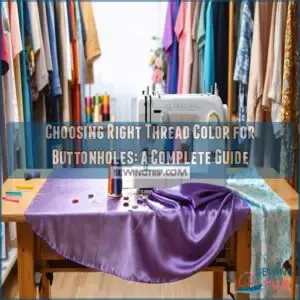
For a seamless look, go a shade darker than your fabric, which helps the stitches blend beautifully.
Want your buttonholes to stand out? Pick a bold, contrasting color for a decorative pop.
If you’re working with patterned fabric, match the thread to the dominant or base color for harmony.
Polyester thread is versatile and durable, but silk adds that touch of luxury.
Always test under natural light—it reveals true colors.
And remember, sometimes, the smallest details turn “meh” into masterful.
Table Of Contents
Key Takeaways
- Match the thread color to your fabric’s dominant tone for a seamless look or go bold with a contrasting color to make your buttonholes stand out.
- Choose slightly darker thread shades for natural blending while avoiding mismatched hues for better harmony and a polished finish.
- Always test thread colors under natural light to see true hues and ensure your choice complements the fabric in your final setting.
- Pick thread types based on your fabric and project needs, like durable polyester for stretch fabrics or luxurious silk for elegant finishes.
Thread Color Importance
Choosing the right thread color for buttonholes can make or break your project’s overall look.
It’s not just about matching the fabric; well-chosen thread enhances the finish and adds a polished touch.
Fabric Dominant Color
Nailing thread color selection starts with matching the fabric’s dominant tones.
When looking at thread color palettes, prioritize fabric shades that pop most.
For a seamless look, here’s the plan:
- Match thread color to the key fabric hue.
- Pick slightly darker hues for natural blending.
- Avoid total mismatches—color harmony matters.
Fabric color matching guarantees balanced, polished buttonholes.
Seam Blending Techniques
Don’t stress about perfect thread color matching; aim for blending colors that reduce seam visibility.
Slightly darker thread tones melt into fabric grain better than lighter ones.
Watch your stitch length and thread tension—they impact how subtle or obvious seams appear.
Here’s a quick guide:
| Aspect | Impact | Tip |
|---|---|---|
| Thread Tone | Seam visibility | Choose darker over lighter. |
| Stitch Length | Surface blending | Avoid too-long stitches. |
| Fabric Grain | Thread harmony | Match thread direction. |
Topstitching Contrast
In the context of topstitching, contrast can be your best friend for creating visual appeal.
A bold buttonhole thread color against the fabric makes stitches pop, showcasing texture and craftsmanship.
It’s all about finding color harmony—choose embroidery thread colors that balance with your design.
For subtle stitch contrast, opt for shades close to your fabric’s dominant tone without blending completely.
Thread Types Overview
So, you’ve thought about blending thread color with fabric, but now let’s talk about thread types—because not all threads are created equal.
Different thread materials and fiber options can make or break your buttonholes. For most classic projects, all-purpose thread works well, regardless of sewing thread colors.
However, buttonholes on delicate fabrics may call for silk thread, which offers a smooth finish and adds elegance. On stretch fabrics? Polyester threads give you strength and flexibility.
If you’re chasing bold stitch effects, contrasting embroidery thread colors work wonders. Remember, thicker yarn types can overpower lightweight fabrics, so match the thread to the fabric’s weave pattern.
The right choice isn’t just about thread color; it’s about setting the foundation for durable, polished stitching. Understanding the various thread types for sewing is essential for achieving professional-looking results in your projects.
Buttonhole Thread Selection
You’ll find that choosing the right thread for your buttonholes makes all the difference between professional-looking results and a mess you’ll want to hide.
Whether you’re working with cotton, polyester, or silk thread, you’ll need to match both the weight and color to your fabric for that perfect finishing touch.
Cotton Thread Uses
Cotton thread shines with loose-fitting garments, offering that perfect matte finish you’re looking for in buttonholes.
When choosing thread color for cotton fabric, you’ll want white thread for printed patterns – it practically disappears into the fabric.
Here’s a pro tip: if you’re planning to tie-dye your project, stick with cotton thread.
Just remember to clean your sewing machine afterward, as cotton tends to shed.
For the best results, consider using button thread options that match your project’s specific needs.
Polyester Thread Uses
When selecting thread for buttonholes, polyester thread stands out as a versatile champion.
You’ll find it’s perfect for projects needing extra durability, especially in knits or fabrics with spandex.
Its UV resistance and colorfastness guarantee your buttonholes won’t fade or weaken over time.
For machine sewing, polyester thread‘s strength handles high-speed stitching beautifully, while maintaining consistent tension and clean edges in your buttonhole work.
The choice of polyester thread types can substantially impact the overall quality and appearance of your sewing projects.
Silk Thread Uses
Masterfully crafted silk thread elevates your luxury sewing projects with unparalleled smoothness and durability.
For high-end fashion buttonholes, you’ll find silk thread‘s natural sheen creates stunning results while sliding effortlessly through fabric without leaving press marks.
Whether you’re working on fine embroidery or hand-sewn buttonholes, luxury sewing projects‘ requirements are met as silk thread’s strength and versatility shine through.
You’ll appreciate that matching thread colors becomes secondary to the silk’s inherent beauty.
Thread Weight Considerations
You’ll want to pick your thread weight based on your fabric’s thickness, since heavier fabrics need thicker threads for durability.
For the best results, match your buttonhole thread to both the weight of your fabric and the size of your buttons – this guarantees your buttonholes won’t appear too bulky or too flimsy.
Thicker Threads Uses
When you’re working with heavy-duty fabrics, thicker threads are your go-to choice.
For dense weave techniques and thick fabric sewing, use thread that matches the fabric’s bulk – it’ll hold up better under stress.
Choose heavy-duty threads (size 30-40) for denim, canvas, or upholstery buttonholes.
Here’s a pro tip: test your thread color choices on a scrap first to verify your thick stitch methods look polished.
Thinner Threads Uses
While thicker threads handle heavy lifting, thinner threads excel in precision work.
Thread weights like 80 and 100 wt InvisaFil thread create nearly invisible seams that won’t draw attention away from your design.
Here’s where thinner threads shine:
- Fine stitching on delicate seams, perfect for silk and chiffon
- Thread color matching becomes easier since lighter threads blend naturally
- Detailed embroidery floss colors pop without bulk
Fabric Thickness Matching
In the context of matching thread thickness with fabric, you’ll want to pair similar weights for the most polished look.
You wouldn’t use delicate thread on denim any more than you’d use heavy-duty thread on silk chiffon.
| Fabric Type | Recommended Thread Weight |
|---|---|
| Lightweight Chiffon | 60-80 wt Fine Thread |
| Medium Cotton | 40-50 wt All-Purpose |
| Heavy Denim | 30-40 wt Heavy-Duty |
| Stretchy Knits | 50-60 wt Polyester |
| Canvas/Upholstery | 20-30 wt Extra Strong |
The table provides a guideline for thread weight selection based on the type of fabric being used, ensuring a proper match for a polished finish, and considering the fabric type is crucial for this selection.
Choosing Thread Color
Choosing the right thread color for buttonholes can make or break the look of your garment.
Whether you’re matching fabric tones or adding contrast, it’s all about balancing style and practicality.
Matching Fabric Color
Matching thread color to your fabric feels like solving a color theory puzzle.
Aim for thread hues that mirror dominant fabric shades—close matches keep seams subtle.
Slightly darker tint matching works better than lighter ones for blending.
Watch out for dye lots; they vary.
For embroidery floss colors, bring fabric swatches to guarantee perfect thread matching.
Understanding the thread color systems is vital for achieving accurate and consistent color matches in various embroidery projects, which involves solving a color theory puzzle.
Contrasting Thread Colors
Choosing thread colors for sewing doesn’t mean blending every time.
Contrasting thread can add flair and show off craftsmanship.
Think:
- Bold pops: Pair dark fabric with embroidery floss colors in bright tones.
- Subtle accents: Use light threads for gentle highlights.
- Purposeful mismatches: Experiment for design accents and contrast effects.
Balance contrast against fabric tone for a harmonious, visually appealing finish.
Future Design Changes
Think ahead when picking thread colors for sewing buttonholes—fashion changes, and your project should keep up.
Choose neutral or versatile shades for better style adaptation later.
Trends shift, fabrics evolve, and having room for design flexibility saves headaches.
Good aesthetic planning means prioritizing thread colors for fabrics that’ll still work if you switch buttons or tweak designs, allowing for better style adaptation.
Thread Quality Factors
Regarding buttonholes, thread quality can make or break your project. Choose smooth, strong thread and steer clear of anything lumpy to avoid frustrating breaks and uneven stitches.
Smoothness Importance
Smooth thread matters more than you’d think.
It creates a significant impact on the quality of sewing projects, as rough threads create nasty snags and mess with your stitches, especially when working with delicate fabric finishes.
Yarn smoothness and fiber quality impact fabric friction, so smooth options keep everything gliding along beautifully, which is crucial for achieving professional results.
In sewing thread selection, always inspect surface finish—lumpy threads lead to headaches, while sleek ones guarantee seamless color matching threads, and using smooth sewing threads can substantially improve the overall quality of your sewing projects.
Strength Importance
If smoothness keeps things running smoothly, strength guarantees your thread can handle the pressure.
Thread durability and fabric resistance are key for long-lasting buttonholes.
Weak thread often snaps under sewing tension, sabotaging progress.
Opt for strong thread types to prevent breakage and boost material longevity.
Strong thread selection certifies your thread color stands the test of buttonhole sewing.
Lumpy Thread Issues
Old, lumpy thread is a recipe for disaster in buttonhole sewing.
It causes thread breakage, knot formation, and friction problems that ruin your seams.
Watch for these signs:
- Uneven texture or fiber fraying.
- Weak pull strength, breaking under tension.
- Yarn quality degrading, creating tangles.
- Sticky or brittle feel during use.
Opt for smooth, durable thread types for effortless sewing.
Buttonhole Construction Tips
When building perfect buttonholes, start with sturdy interfacing to keep the fabric from warping.
Make sure your stitching is precise and the size fits your button snugly for a polished finish.
Interfacing Necessity
Why’s interfacing such a big deal for buttonholes?
It keeps your fabric steady, prevents puckering, and makes all that thread selection shine.
Choosing the right stabilizer is essential for sewing perfect buttonholes, as it involves understanding thread tension adjustment techniques.
Choose a stabilizer suited to your fabric and design—too thin, and it won’t hold; too thick, and it’s a hassle.
Here’s a quick reference:
| Fabric Type | Interfacing Type | Reinforcement Level |
|---|---|---|
| Light Cotton | Lightweight Fusible | Gentle Support |
| Denim | Medium Sew-In | Strong Stabilizer |
| Silk | Sheer Fusible | Minimal Reinforcement |
Buttonhole Size Guidelines
Getting buttonhole size right? It’s all about precision.
Follow this:
- Measure the button: Add 1/8 inch for a smooth fit.
- Think fabric thickness: Thicker fabrics need slightly larger buttonholes.
- Adjust stitch length and thread tension: Short stitches give strength; balanced tension prevents puckering.
Master these, and your buttonhole stitching stays accurate, leaving room for thread colors to shine!
Stitching Techniques
Mastering buttonhole stitching starts with even stitch tension.
Use a sharp needle for precise work and sewing embroidery threads for durability.
Maintain steady sewing speed—rushing leads to mistakes.
Watch for fabric stretch during stitching to avoid puckering.
Secure thread knots to keep edges smooth.
Choose thread colors for fabrics wisely; thread choices set the tone.
| Factor | Tip | Why It Matters |
|---|---|---|
| Stitch Tension | Keep stitches even | Prevents puckering and uneven edges |
| Needle Selection | Sharp needles or embroidery ones | Guarantees accuracy and clean results |
| Sewing Speed | Go slow and steady | Reduces errors and uneven stitching |
| Thread Knots | Secure tightly | Keeps thread and stitching intact |
Gimp Thread Uses
You’ll love how gimp thread adds structure and a polished edge to your buttonholes while keeping stitches smooth and secure.
Choosing a color that blends seamlessly with your fabric guarantees a professional finish every time.
Decorative Buttonhole Edge
Edge stitching a decorative buttonhole isn’t just functional—it’s a design detail.
Enhance buttonhole accents with gimp threads that match or contrast fabric textures, use thread wrapping for seamless edges or stitch embellishments with embroidery floss selection for bold patterns.
Try a decorative buttonhole stitch for flair while keeping thread colors for fabrics cohesive.
Understanding decorative edges can greatly enhance the overall appearance of a garment.
Small touches elevate any garment, making design detail an essential aspect of creating a visually appealing piece.
Thread Color Matching
Matching thread color to fabric can feel like finding the perfect jazz rhythm—it’s all about harmony.
Stick to these tips:
- Opt for darker thread shades for better blending.
- Test fabric tones and dye lots for consistency.
- Prioritize subtle hues for clean finishes.
- Balance aesthetics through thoughtful hue selection.
- Bring fabric swatches for foolproof embroidery floss selection.
Color harmony makes projects pop!
Visibility Importance
Visibility is your buttonhole’s secret weapon—don’t let it fade into the fabric.
Thread visibility depends on the right thread color and type.
A bold color contrast adds style, while blended tones keep it subtle.
Match thread visibility to fabric texture and stitch appearance.
Choose wisely for visual impact—because thread type and sewing thread tell their own story.
| Thread Type | Best Use | Visibility Impact | Style Tip |
|---|---|---|---|
| All-Purpose Thread | Everyday sewing | Moderate | Keep tones subtle |
| Embroidery Thread | Decorative stitches | High | Choose bold colors |
| Cotton Thread | Lightweight fabrics | Subtle | Match to fabric |
| Polyester Thread | Stretchy materials | Moderate | Emphasize texture |
Sewing Method Selection
Choosing the right sewing method for buttonholes guarantees your thread works smoothly and holds up over time.
Use machine thread for machine sewing and hand-sewing thread for hand stitching to avoid breakage or tangling.
Machine Thread Uses
Not all machine threads are created equal, but choosing the right one can save your project from unraveling—literally.
For buttonholes, machine thread offers reliable durability and precision.
Keep these tips in mind:
- Use sewing thread compatible with your fabric.
- Adjust machine settings for stitch quality.
- Match thread color for seamless buttonholes.
- Balance thread tension for even stitches.
- Explore thread types for specific needs.
The key to a successful project is understanding that machine thread offers a range of benefits when used correctly.
Hand-Sewing Thread Uses
When hand stitching buttonholes, handsewing thread is your go-to for control and precision.
Choose embroidery thread for decorative edges or standard handsewing threads for durability.
Proper Fabric Preparation guarantees smoother sewing.
Thread Management is key—avoid tangles by using shorter lengths, and don’t forget consistent Thread Tension for polished results.
Thread Twist Importance
Thread twist matters more than you’d think.
It affects how fibers hold together, impacting thread quality and longevity.
Watch for these when you’re picking thread for buttonholes:
- Z-twist for machines, S-twist for hand sewing.
- Match twist types to sewing methods.
- Avoid breakage from mismatched spins.
- Check fiber orientation for smoother stitches.
- Prioritize twist for buttonhole twist thread durability.
Finalizing Thread Choice
Choosing the right thread color takes a bit of patience, but the results are worth it.
Use thread sample books and color matching tools to confidently lock in the perfect match for your project.
Practice and Experience
Practice makes perfect in sewing buttonholes.
Grab scraps, test embroidery thread selection, and analyze errors before committing to your project.
Stitch practice builds Sewing Mastery over time.
Experiment with thread trials to refine your thread color choice.
| Practice Tip | Reason |
|---|---|
| Test on scraps | Saves fabric from mistakes |
| Try different threads | Finds the best match |
| Adjust tension | Guarantees neat stitches |
| Review stitches | Spot and fix flaws |
Regarding sewing buttonholes, regular practice is key.
By doing so, you can commit to your project with confidence.
Thread Sample Books
Feeling overwhelmed by thread color selection?
Thread sample books are your secret weapon.
These compact catalogs let you compare real color swatches to your fabric, ensuring perfect matching.
Plus, they’re a dream for embroidery thread selection, offering a quick peek at thread types and textures.
Keep one handy for organized sample storage and stress-free project planning.
Utilizing thread sample books can greatly simplify the process of choosing the right thread for your projects.
Color Matching Tools
Nailing the perfect thread color? It’s easier with the right tools.
Try these:
- Color Wheels: Great for understanding hues and contrasts.
- Thread Cards: Handy for comparing actual thread samples.
- Fabric Swatches: Always match thread directly to your garment.
- Digital Matchers: Modern tech for precise color selection.
Mix these with thread sample books for spot-on fabric matching.
Frequently Asked Questions (FAQs)
How do you pick the color of thread?
Go with a thread color that blends with your fabric’s dominant tone.
When in doubt, pick a shade slightly darker—it hides better.
Want contrast? Choose a bold color to make your buttonholes pop stylishly!
How would you choose the appropriate color of the thread?
Think of thread color like picking the perfect accessory—it should complement your fabric.
Match the dominant color, lean darker for blending, or go bold with contrast if you’re after a statement buttonhole.
What color should button holes be?
Buttonhole thread color depends on the look you’re after.
Match your fabric for a seamless finish or go bold with contrast for flair.
Stick with subtle tones if you’re unsure—it’s hard to go wrong!
Should thread be lighter or darker than fabric?
Picture fabric and thread side by side—go a shade darker for blending.
Darker threads naturally sink into fabric seams, while lighter threads stand out.
It’s a small trick that keeps your stitching nearly invisible.
How do thread finishes affect durability?
Thread finishes, like waxing or mercerization, boost durability by strengthening fibers and reducing fraying.
Waxed threads glide smoothly for hand sewing, while mercerized threads resist wear.
Opt for these when you want your stitching to withstand the test of time.
Can thread color impact buttonhole appearance under lighting?
Lighting can totally shift how thread colors look on buttonholes.
Natural light shows true hues, while artificial lighting can dull or distort them.
Always test thread under similar lighting to your final garment setting, considering natural light shows the true appearance of the thread.
What thread colors suit patterned fabrics?
Imagine trying to match thread to a vibrant floral fabric—tricky, right?
Go with a subtle tone found in the print.
If patterns are bold, pick a color that blends without stealing the spotlight.
Are metallic threads suitable for buttonholes?
Metallic threads can work for buttonholes, but they’re tricky.
They’re decorative threads, not workhorse threads, and might fray or snap under stress.
Use them sparingly—for showy accents on lightweight fabrics, not heavy-duty closures.
How does thread dye quality influence fading?
Did you know poor dye quality can cause thread to fade after just a few washes?
Always pick threads from trusted brands to avoid dull, discolored buttonholes—nobody wants a wardrobe that screams “washed out”!
Conclusion
Picking the right thread color for buttonholes is the cherry on top of your sewing project—it ties everything together.
Whether you’re blending with the fabric for a polished look or using a contrasting shade for flair, the key lies in testing and balancing your choices.
Consider thread type, fabric thickness, and your design vision to achieve the best results.
With careful attention to detail, choosing the right thread color for buttonholes transforms the ordinary into extraordinary.

